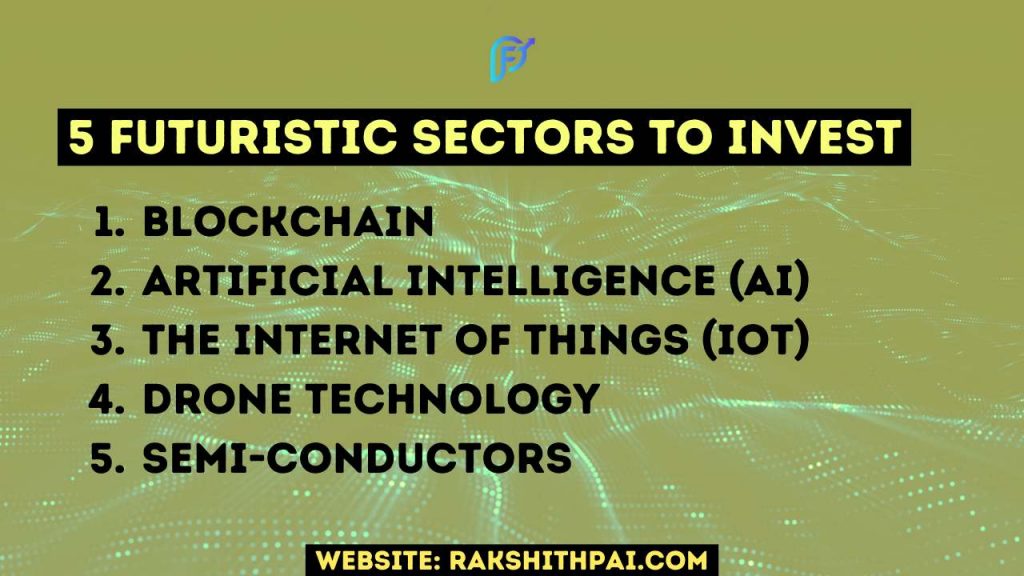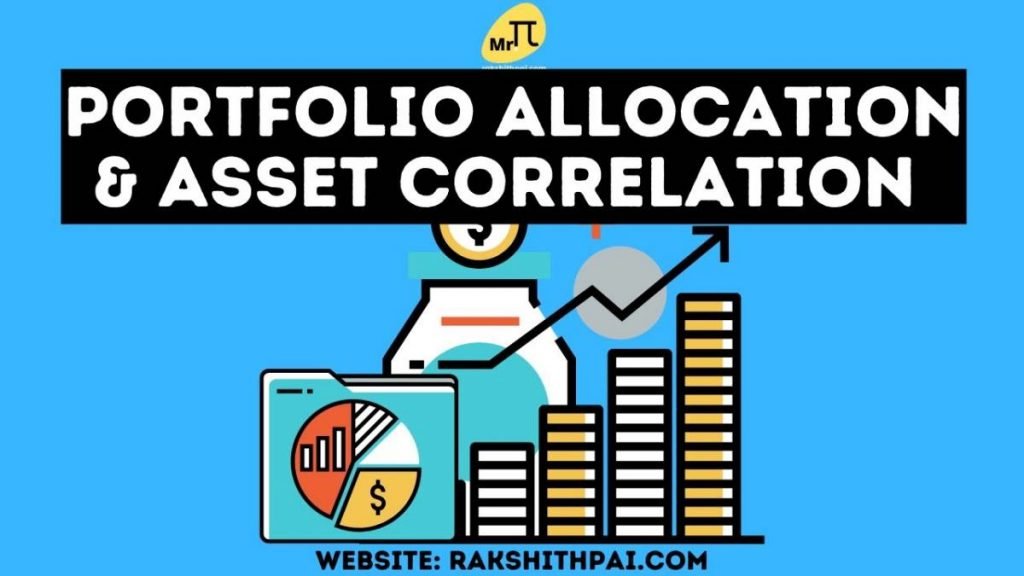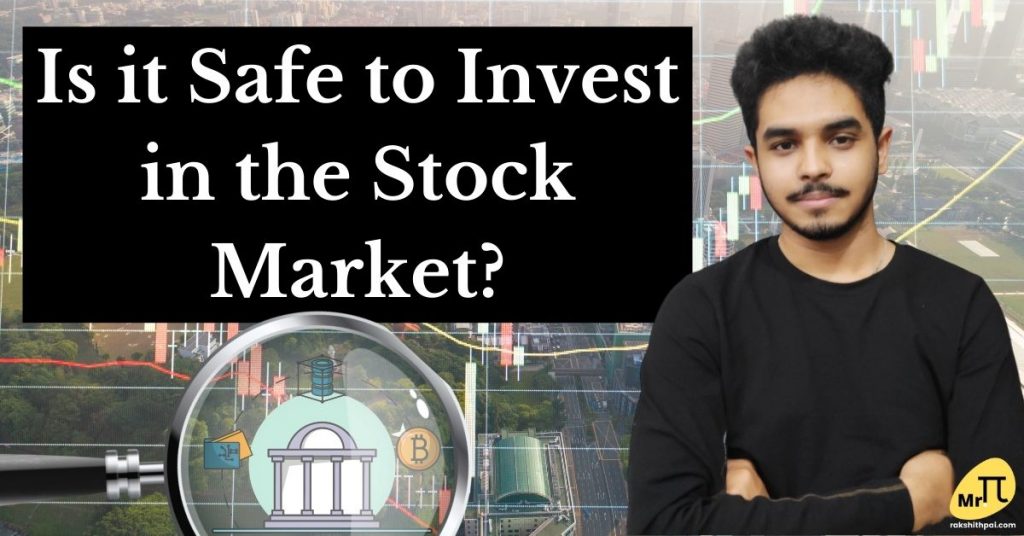Table of Contents
What does Futuristic Sector Mean?
Futuristic Technologies are the reinventors. They strategize & transform the sector drastically. All the futuristic sectors rally behind a strong online presence. Meaning, working all that can be done via the internet. And, doing the same by all available shortcuts thus saving time & manpower.
Industrial robots, Artificial Intelligence (AI), and Machine Learning (ML) are just a few examples of emerging technologies that are developing quickly. Even though these innovations have the potential to cut costs while also speeding up production and improving the quality of products, they also have the potential to put a lot of people out of work.
People who think futuristically are able to see beyond the immediate future and imagine what could be. They can think of new ways to look at customers, products, services, business strategies, and business structures.

5 Futuristic Sectors to Invest in:
Blockchain
Blockchains are a type of Distributed Ledger Technology (DLT) in which a list of records (blocks) that keeps growing is cryptographically linked to other blocks. In simple words, a blockchain is a digital ledger for anything. You can record transaction details such as stock trading, property, etc and the recorded “block” is tamperproof. Once entered, only those with authority can change the data.
A blockchain is a digital ledger consisting of linked blocks of data. The specifics of what’s kept in a blockchain’s blocks vary greatly. A Bitcoin transaction block, for instance, may record the transaction’s sender, its recipient, and the total quantity of bitcoins being sent. A blockchain, meanwhile, is a decentralized database that powers cryptocurrencies like Bitcoin. While blockchain technology is what drives Bitcoin, it has numerous other applications as well.
With a CAGR of 68.4% between 2021 and 2026, the blockchain market is expected to grow from its 2021 valuation of $4.9 billion to a whopping $67.4 billion by 2026. In India, the banking and finance sector has been the primary beneficiaries of using blockchain technology.
Digital asset exchange Cross Tower and the US-India Strategic Par Partnership Forum predict that the value of the digital asset economy will increase from $5 billion in 2021 to $262 billion over a period of 11 years, contributing $1.1 trillion to India’s GDP. This growth is due in large part to blockchain technology and Web 3.0 innovations.
Artificial Intelligence (AI)
“Artificial intelligence” refers to the emulation of human intelligence processes by machines, primarily computer systems. Expert systems, natural language processing, speech recognition, and machine vision are all examples of specific ways AI can be used. It also has natural language processing (NLP), expert systems, speech recognition, machine vision, and machine vision.
Improvements in AI could help improve the customer experience, improve the efficiency of business operations, bring in more money, and help create new business models. After seeing developments in the business sector and understanding the potential benefits of AI, organizations have increased their investment in AI projects and adopted an AI-first strategy.
Businesses use artificial intelligence (AI) systems such as CRM, ERM, and others to manage operations, develop supply chains in response to real-time or anticipated demand, and increase ROI and cost savings.
According to a study conducted by International Data Corporation (IDC), India’s AI business would be valued at $7.8 billion by 2025, growing at a CAGR of 20.2%. By the end of 2025, the AI software category will dominate the market, having grown at a CAGR of 18.1% from $2.8 billion in 2020. The majority of software sector revenue (AI) was generated by applications.
Best Information Technology stocks to buy in India 2022
The Internet of Things (IoT)
The “Internet of Things” (IoT) is a network of “things” that have electronics, software, and network connections so they can share data with other devices and systems online. The term “Internet of Things” is used to describe the ever-expanding network of interconnected devices that may communicate and share data in real-time through the use of built-in sensors. Connecting your thermostat, car, lights, and fridge to the IoT is a simple task.
Between 2020 and 2025, the Indian IoT market is expected to grow at a CAGR of 13.2 percent. Businesses in India are struggling to implement the Internet of Things due to issues with legacy systems, communication protocols, and the high costs associated with rolling out IoT on a wide scale. IoT vendors can help businesses with their digital transformation, including automation, by using their vast knowledge of the world and a wide range of IoT products and services.
Increased use of the Internet of Things in precision farming will drive growth in the market over the predicted horizon. In order to provide individualized attention to each plant, precision farmers utilize a wide variety of technologies, including geographic information systems (GIS), artificial intelligence (AI), robots, sensors, global positioning systems (GPS), and data analytics programs. Today, big companies like Amazon Web Services, Cisco Systems Inc., Google, Oracle Corporation, and others run the Internet of Things (IoT).
Drone Technology
Drones are increasingly used for a wide variety of tasks, such as weather observation, disaster relief, search and rescue, aerial photography, videography, and package delivery. But the military is probably the most well-known and controversial use of drones. They are used for reconnaissance, surveillance, and targeted attacks.
Even while drones have been present for some time, it is only in the wake of the COVID-19 epidemic that their potential uses in other industries have been thoroughly investigated.
According to BIS Research, the global drone industry will reach $28.47 billion this year, with India contributing around 4.25 percent of that total. In addition, by CY2021, the Indian drone market is forecast to be worth $1.21 billion. According to multiple projections, its value will be $1.81 billion by FY2026, representing a compound annual growth rate (CAGR) of 14.61 percent.
Semi-Conductors
The government of India has plans to shift the country away from relying on imports to fulfill the country’s growing semiconductor demand. So, the Indian government offers incentives at every step of the value chain to help the country become economically independent and technologically advanced.
The Indian government recently came up with a plan to make India a global center for designing and making electronic systems by encouraging the growth of a strong semiconductor and display ecosystem.
The Internet of Things (IoT) and fifth-generation (5G) networks are driving an increase in semiconductor chip demand that is predicted to reach over $100 billion by 2025, up from the current $24 billion. In the current geopolitical situation, which places a high value on protecting important information infrastructure, it is especially important to have reliable sources for semiconductors and displays.
As part of its plan to modernize the country’s economy, the government estimated that it would need about Rs 76,000 crores to fund a comprehensive program to expand India’s semiconductor and display manufacturing ecosystem.
7 Best Sectors for Wealth Creation by 2030:
Conclusion:
The Asian Development Bank predicts that governmental and private investment in infrastructure in India would boost GDP growth by 7.5% and 8%, respectively, in fiscal years 2022 and 2023. Thanks to the positive returns they saw in the previous fiscal year (2021), investors are prepared to allocate a bigger portion of their savings to capital instruments in the next year (2022) and are eager to put their money to work in India’s expanding business sectors.
By the conclusion of the fiscal year 2022, many analysts predict that the Indian stock market will have grown and developed to become the fifth largest in the world in terms of market value. Without a doubt, the market will grow because of a number of things, such as government efforts, international relations, the way the market works, and so on.
If you’re interested in investing in India and want to discover which industries have the best future prospects, then the above-mentioned sectors are those that you need to be aware of.
Disclaimer: All the information on this website is published in good faith and for general information purposes only.









